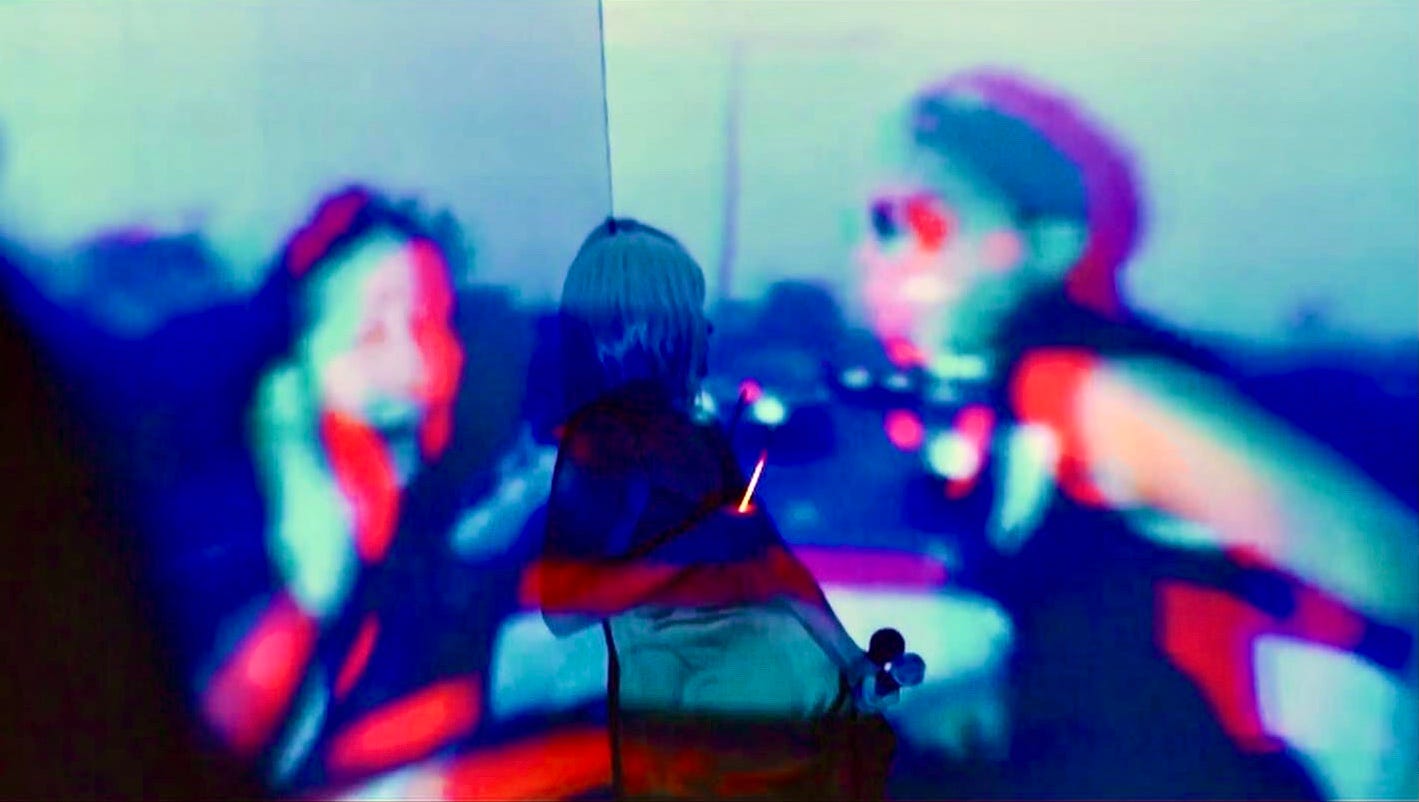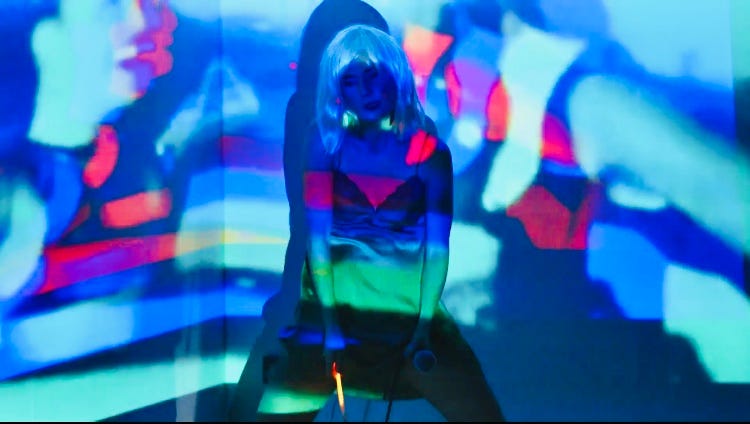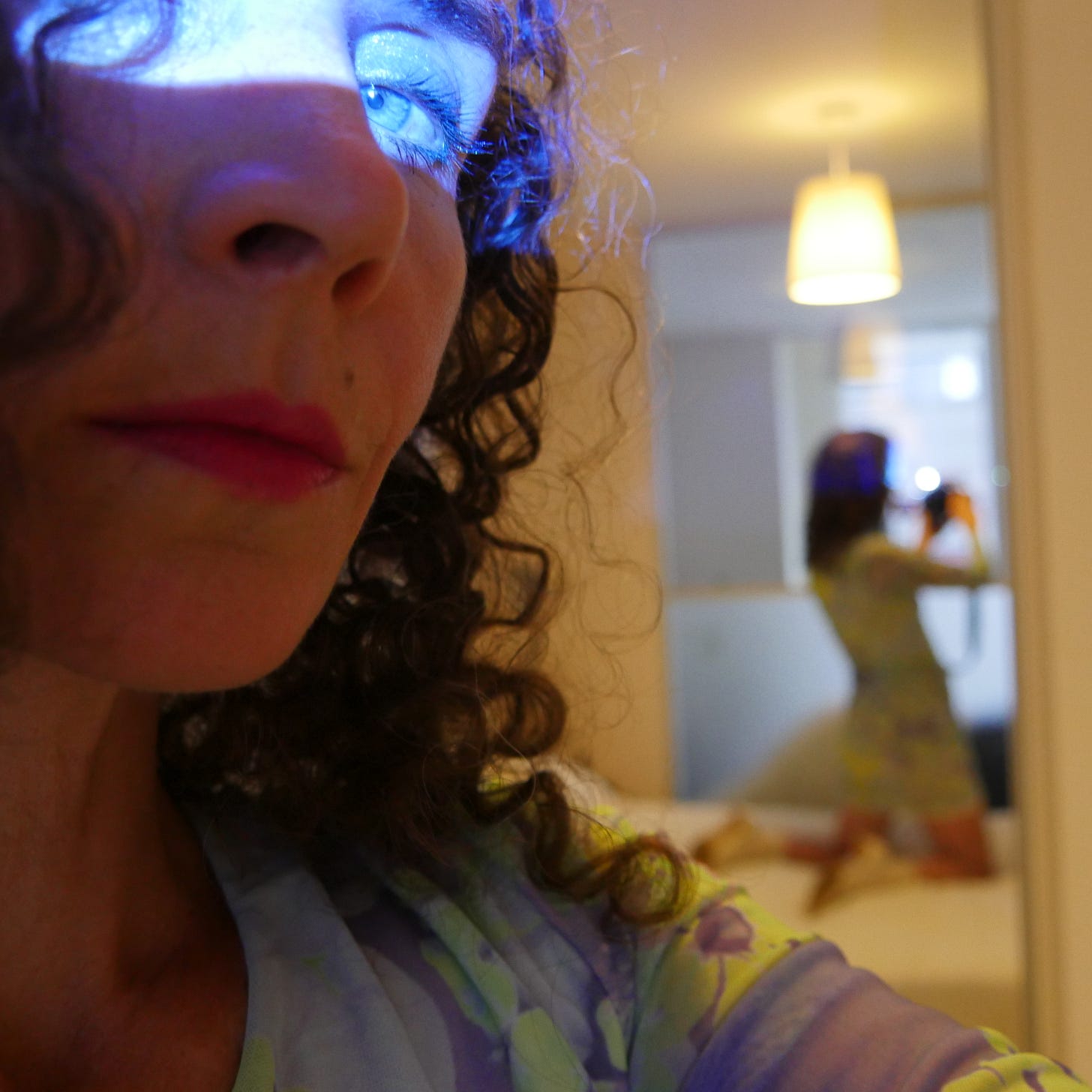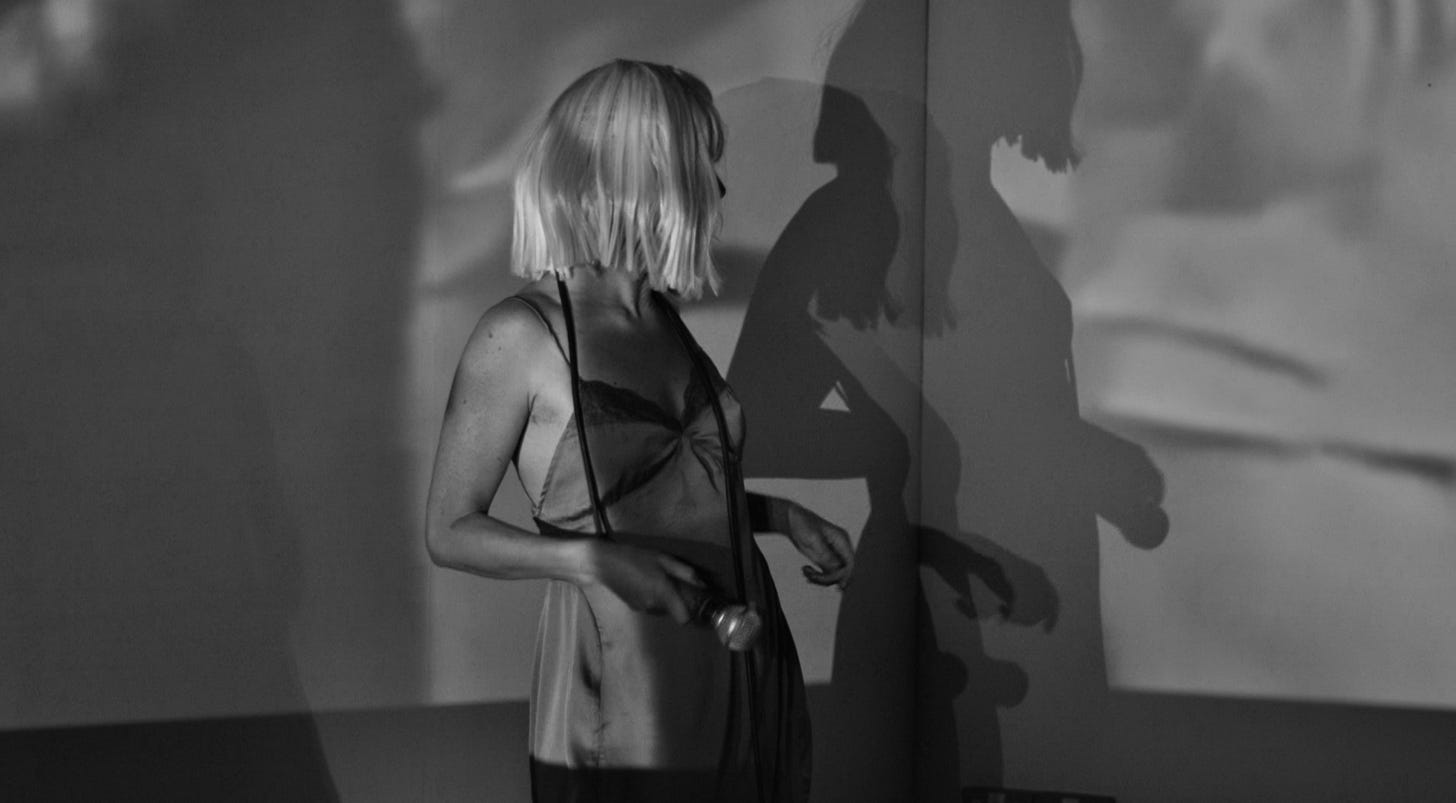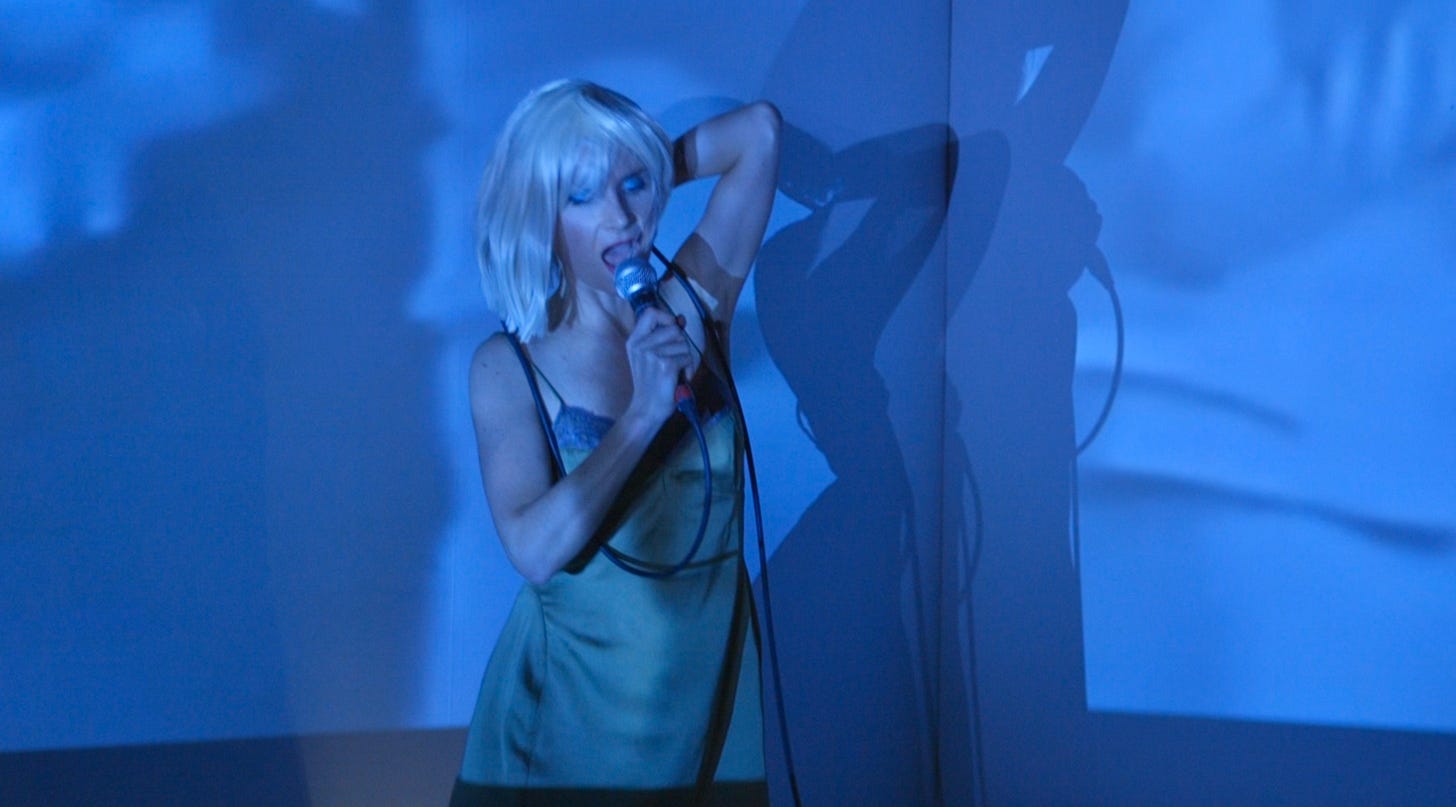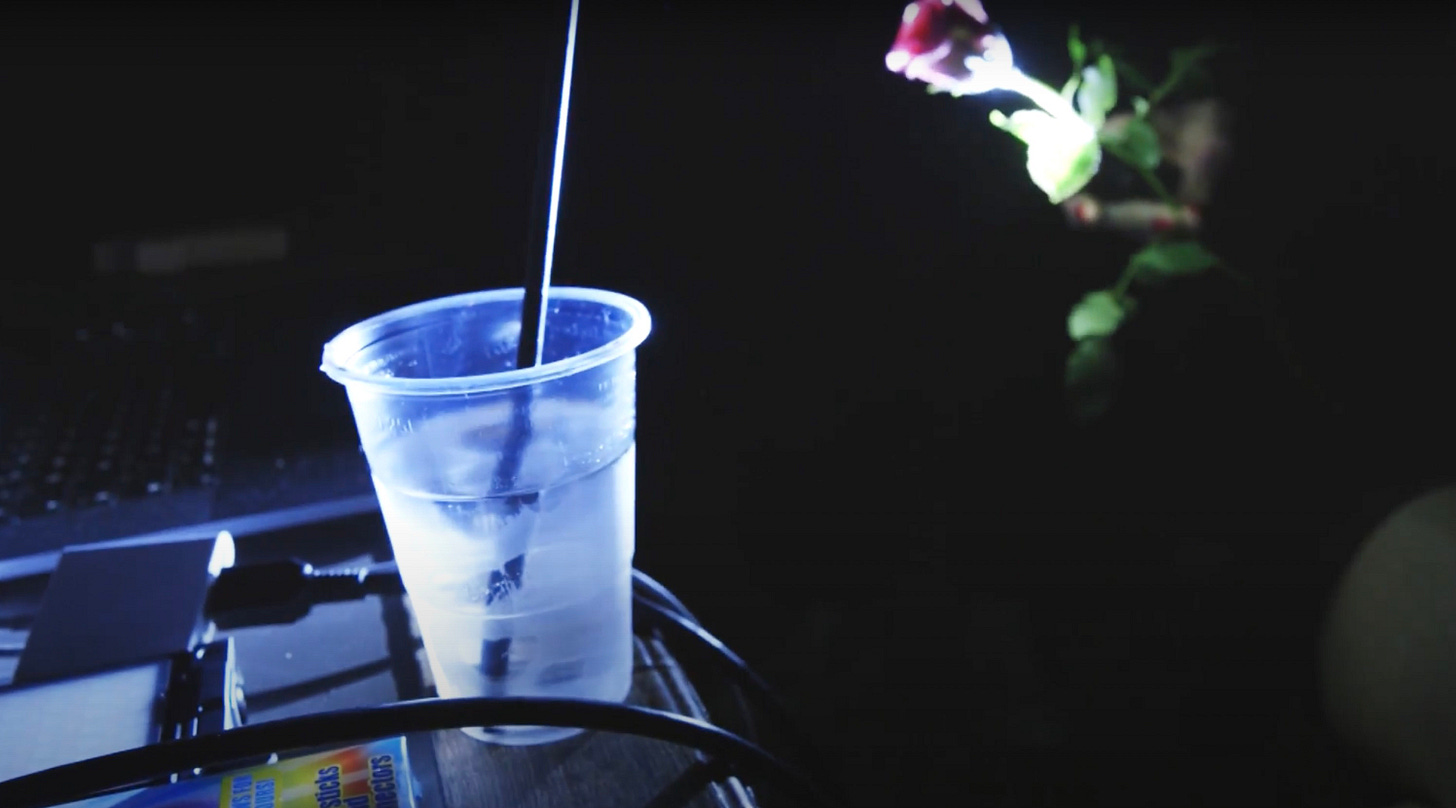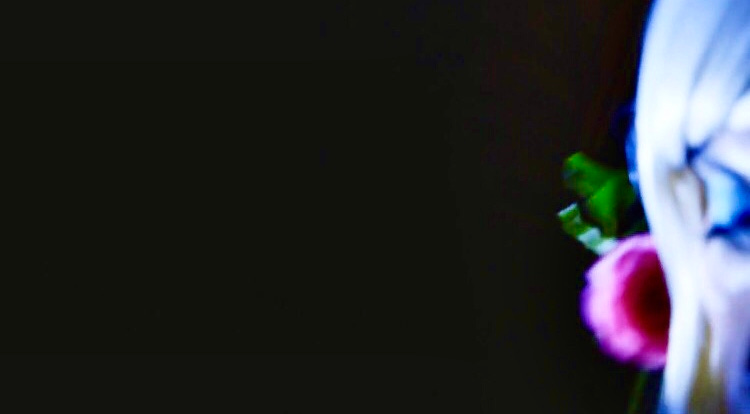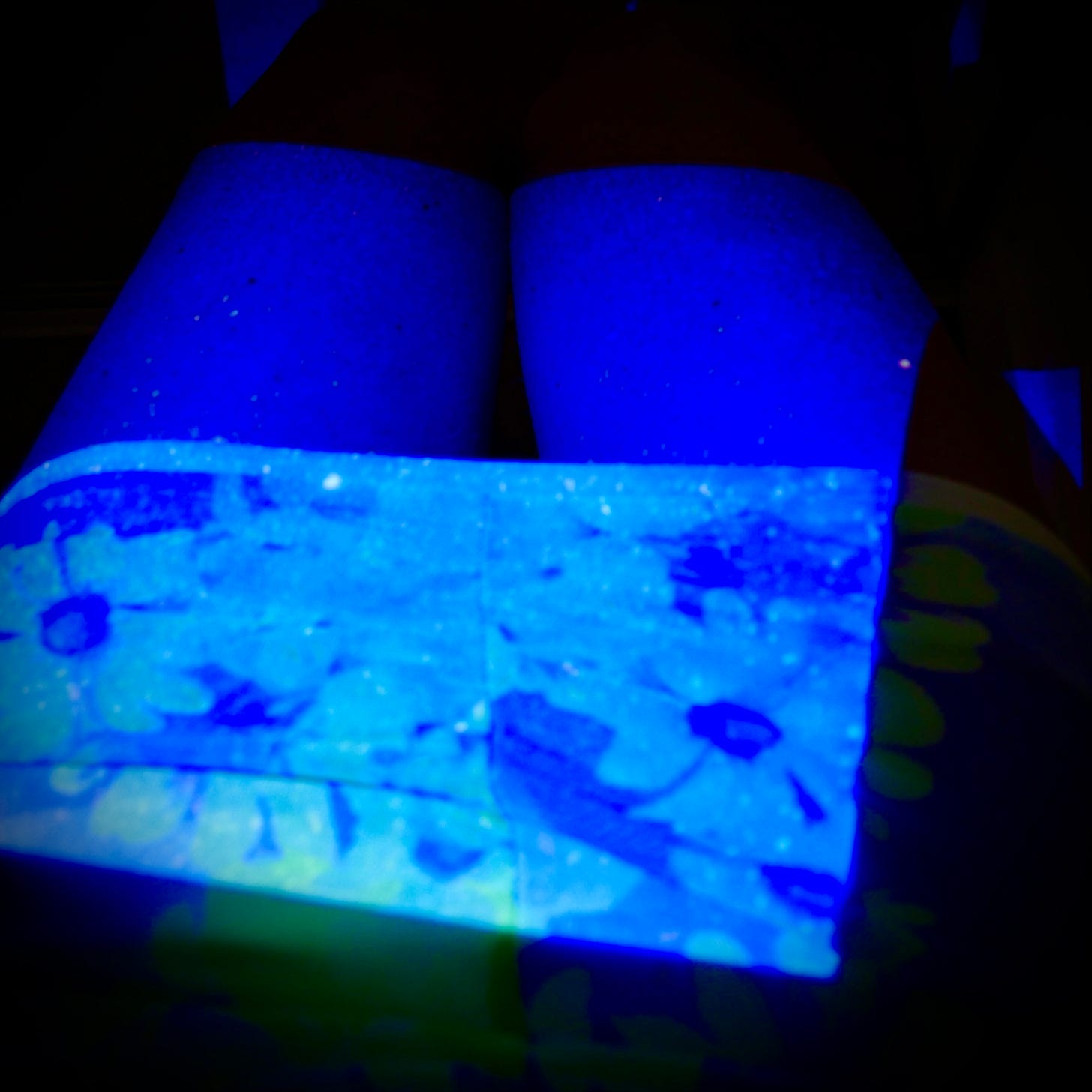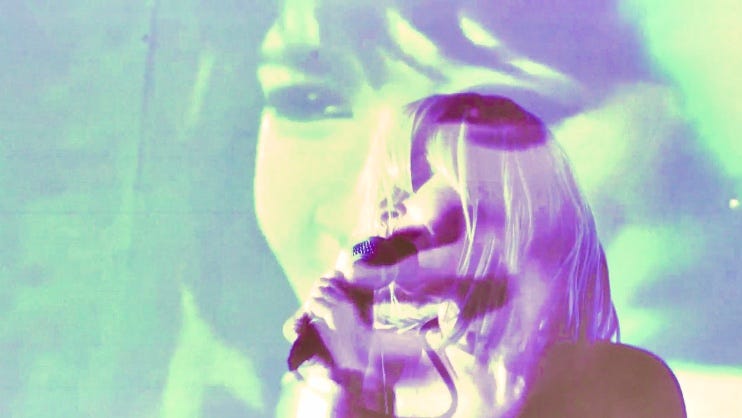That Night in Hawaii When I Turned into a Panther…
"Music is just music but not even that." - Mark Fisher
The penis is an extension, it reaches out, it explores.1 I do not have a penis, so I do not reach out, or explore. Instead, I listen to Radio 4.
Capitalism has permeated our sense of reality so much so that we can no longer imagine otherwise argues Mark Fisher in Capitalist Realism (2009)2 a term he did not coin but which is woven into systems of production, culture, work and education so seamlessly that we can no longer imagine otherwise. “If forms of resistance are so hopeless and impotent, where can an effective challenge come from?” (Fisher, quoted in de Selby, 2017b).3
Three voices:
“You’re a singer, not a writer.” - A friend
“You need to get rooted, you’re all fragments, but you have so much potential, you know what I think anyway, you’re a prophet.” - Fellow PGR/collaborator
“It’s a living archive, you’re wrangling, with it, with your life… It feels right…I think this is how you were always going to do it.” - My supervisor
Music is just music but not even that
In “Archive Fever: A Freudian Impression” (1995)4, Jacques Derrida refutes the Western preoccupation with starts, beginnings and origins. He critiques technologies of inscription and psychic processes, in particularly email, arguing that they’ve irrevocably altered public and private space. He draws upon Freud’s concept of Thanatos (the death drive), specifically ‘repetition-compulsion’ which he suggests functions in and through the archive as it does in psychoanalysis: a returning force to a beginning. For Derrida, then, the archive is both a public and private repository and a zone for more intimate disclosure which is not time-bound but future-oriented.
Fisher’s posthumous blogging alias k-punk (2003-2013)5 not only enabled him to write about music but to write in public when public space is being increasingly privatised. K-punk is relevant here for various reasons, including that inferred in the title of my publication, in that I would be writing about music and more but also as a blogging alias. Fisher cites in interviews that his blog set about his career trajectory, whilst stressing that neither an academic press or a mainstream media outlet would have even considered it (de Selby, 2017a)6.
In this talk, Fisher in conversation with Green Gartside on politics and music at the 2011 Off the Page festival: “music is just music but not even that” (de Selby, 2017a, 00:15:19-00:15:24). He has also suggested that the type of thinking it leant itself to liberated him from that engaged with on his doctorate (Wilson, 2017).7
In conversation with the musician, Green Gartside, on politics and music at the 2011 edition of Off the Page festival, Fisher concludes, “[m]usic is just music but not even that” (de Selby, 2017a, 00:15:19), hence my subtitle. Through this publication, I’ve been attempting to convey this property, aiming to ‘write-up’ my PhD in a living, breathing, even sensual way, if possible.
On wrangling
Over the five years, this doctorate has been a case of wrangling with it, life, myself. Yet, this only mirrors what an album is, or does, in that they contend with the world (Grubbs, 2014)8. Perhaps the idiosyncratic, and not easily categorisable, album matters more in a flattened, digital ecosystem of algorithmic playlists, and AI-generated tunes and algorithmic reproduction.
Adorno’s intellectual escapades in the avant-garde and his denouncement of the ‘culture industry’ paved the way for such musical sociological analysis and the subsequent critical fusion of high-theory with popular culture. Such a focus opposed the Western musicological canon which had dominated with its post-Romantic and apolitical focus on formalism, in which music was not to be sullied by real-world concerns, having “no other content than music itself” (McClary, 1994, xi).9
Conversely, Terry Eagleton reiterates the notion of art being automatically political. To quote, from his recent lecture “Where does culture come from?” (2024) published in The London Review of Books, “[t]he aesthetic I think only ever becomes important when it speaks to more than itself”.10
On TLC
Records embalm a moment in time. As objects, they are fragile, despite being made of plastic. We handle them like we might cash, with some regard. They are historical in their presence and yet simultaneously dead. The recorded voice is a ghost of itself. They come in inner sleeves which denote their fragile status via lettering and instructions to that effect. A stray needle can cause damage. They are prone to scratches and scuffle and ask to be cleaned with velvet, no less. The act of putting a record on is a pleasurable ritual. They are relatively heavy, too, which is satisfying. Blackout Baby is heavyweight juxtaposed with the lightness of the paper sleeve; whereas digital albums zig zag about in the ether, weightless. In the event that they are neither streamed, nor downloaded, they sit on huge servers in warehouses which are pumping energy 24.7, surrounded by fans. Some are never played.
On receiving the one-cut vinyl for Blackout Baby which I explore symbolically in The Path of Totality, I discarded the sub-par gatefold and re-dressed it in a rare black sleeve, with a set of mono photos designed to fall out on being handled. This felt more in keeping with the unique artefact or in Benjaminian terms, its ‘aura’.
I enjoyed tossing the gatefold and leaving the heavyweight vinyl to do the talking, unshrouded in commercial garb. With the gatefold went the printed lyrics, which had been a trial anyhow due to the frequent shift in tenses which occur when doing spontaneous song and inhabiting non-linear temporalities, which do not lend themselves to the patriarchal system of grammar.
‘In here’ and ‘out there’
Speaking on what he terms “psychic privatisation”, Fisher suggests that “everyone has retreated into a private space” (Fisher, quoted in de Selby, 2017b, 00:17:01).
The issue of ‘psychic enclosure’ is topical and the term crops up frequently online. For example, in The Dark Forest Anthology of the Internet (2024), published by The Dark Forest Collective, the “post-individual” is one who seeks and explores new identities online.11 This can involve migrating from social media platforms to closed-chat rooms, Discord servers and more ‘private’ online communities. Such ontological dimensions resonate with Braidotti’s ‘nomadic subject’ which is fragmented and entangled.12 Regarding the inversion of ‘IRL’ and the virtual, the co-authors of The Dark Forest Anthology of the Internet (2024) contend that:
the internet is real life. What we do “in here” matters just as much as — and for some of us, problematically, even more than — what happens “out there.” What happens in here is real life. Our experiences online are adding up to something bigger than any of us.13
Lyrics to Influencer (track 11, Space Junk)
Glowing in that dress, in your glowing, glowing shoes. You could have taken off. You could have flown around the world in those shoes, they were buoyant, buoyant, oceans, oceans. Seven oceans. Would have had you swim, swim across seven oceans. Oceans, they were so buoyant and red. You would have glowed in the dark. Ship navigation systems would have seen you from seven thousand miles away. They would have known you by your glow, your angelic glow. Glowing white in your red shoes on the seventh ocean on the seventh day. You stepped into it. And I curled my hand around you. Asked you what you wanted to do that day. It was snowing outside. With limited options. You said you wanted to ride. We took a sleigh, went to Sainsbury’s. Did a little bit of shopping. Came back. Then you said you wanted to take over the world. I asked you if you wanted a cup of tea first. Then we read “Kafka and his Precursors” by Borges. Talked a little bit about Influencers and attraction. Influencers. Where’s the cutlery? Can you remember when we talked about the cutlery in Campo St. Leo. It was the first time we spoke. Can you remember? When the bells slow and the rhythm changes slightly and I wonder what you’re doing. How can it be that two minds can get connected like that? (Entwined.) “We’re connected” you said, and I thought Oh, here we go again. These virtual intimacies. The way that we insinuate and insinuate. I love you. I love you. I love, you. You, I love. I love, you.
Surveys across the generations asked the sample when they ‘most feel themselves’. Gen Z’s results tipped the halfway point with more respondents reporting that they did so online, rather than offline, whereas Baby Boomers swung the other way. The side-effects of Gen Z feeling more ‘themselves’ online though is being born out in the decline in young men having sex, either in, or out of relationships or by the numbers who even express a desire for a relationship, as well as negative birth rates worldwide and a reduction in alcohol intake. This generation also seem reluctant to answer the phone. Apparently, even Tinder placed an advert the other day advising its users to go out and bump into someone IRL.
DIT = DIY + Together
DIY as a concept is crucial to society and culture in an era of captured institutions but the conditions of DIY, being autonomous and self-reliant, tend to disregard class. Fisher, for example, cited Public Service Broadcasting and NME as having introduced him to Baudrillard and Derrida not the public school system. Nobody can DIY forever though and who would want to? A more recent or realistic acronym is DIT = DIY + Together = a natural extension, a reaching out.
Our alts, souls, and selves
“The internet is where our alts come alive, our internal monologues become dialogues” (Strickler, 2023).14
When composing Space Junk (2023), I found that curated online identities, virtual intimacies, the commodification of self, cloud capital, work, and freedom were themes embedded in the work, which resurfaced both in lyrics, and extended song titles, which I only apply after recording the song.
The titles are taken from the lyrics, as in: “Girl Online”, “Stars (Disappearing Messages)”, “One Tick Man”, “Influencer”, “Pneuma/Non-Commodity”, “Cloud Throne”, “Spreadsheets”, and “A Herd of Buffalo Run Across the 60-Inch Flat Screen TV” and “Dead White Men Working on Overtime”.
The excessive and playful length of my titles mirrors those in André 3000’s new and transcendental 87-minute debut album, New Blue Sun (2023)15 produced by ‘guru’ Carlos Niño which is entirely instrumental, and improvised, steered by his flute.
That Night In Hawaii When I Turned Into A Panther… (and being ‘antennas’)
The title of this article is borrowed from one of the tracks on New Blue Sun. Others I rather liked are “I Really Wanted To Make A "Rap" Album But This Is Literally The Way The Wind Blew Me”; “That Night In Hawaii When I Turned Into A Panther And Started Making These Low Register Purring Tones That I Couldn’t Control... Shit Was Wild”; “But this is the Way the Wind Blew Me This Time”; and “Dreams Once Buried Beneath The Dungeon Floor Slowly Sprout Into Undying Gardens”. On artists being ‘antennas’, he remarks in an interview with NPR (Carmichael, 2023) “As an artist, you got to have really strong antennas. … Everybody has a certain kind of magic show.”16
Scenario:
When illustrating his divided-brain hypothesis, the psychiatrist and philosopher, Dr. Iain McGilchrist, refers to observations on brain-damaged patients. McGilchrist observes how right-hemisphere brain-damaged patients will tend to reach out and ‘grasp’ with their right hand as if they are trying to control something; and conversely, when it it left-brained damage they tend to open their palm in a more gestural manner. In this case, they do not grab, nor clasp, or try to control the world, but instead, explore. Such observations echo Spinoza’s mind-body parallelism. The body, to Spinoza, is not a machine, nor to McGilchrist who is opposed to reductive materialism.
André 3000 is also a unique case in point as an example of both an improvising, nomadic artist whose music very much exists in the present. As does he, seemingly, as embodied in his peripatetic wanderings around Venice, California, playing impromptu on street corners with his flute (much to the pleasure of those who have documented him on social media) but to the chagrin of his fans, the majority of whom just want another rap album.
New Blue Sun17 finds him undergoing a spiritual undertaking of sorts. The ecstatic music of Alice Coltrane would appear to be an influence upon his transcendental jazz. Coltrane’s devotional recordings and earlier albums such as Journey in Satchidananda (1971) and Eternity (1976) feature her beatific harp, which she learned how to play as a gift to John Coltrane, who had ordered it in, and been waiting for months for it to arrive, hoping it would help him re-ignite his approach to harmony and texture. Yet, sadly, it arrived in the post after he had died and so Alice learned how to play it. We could also read into his nomadic wanderings something of the DIY spirit of Moondog (Scotto, 2013).18
I was captivated watching André 3000 and his band perform “That Night In Hawaii When I Turned Into A Panther And Started Making These Low Register Purring Tones That I Couldn’t Control ... Sh*t Was Wild” on The Late Show with Stephen Colbert from January 24, 2024. This was an experience even though I was viewing it through a tiny screen, I could still sense the live energy in the room and the stillness of the audience who seemed to be mesmerised. It began with a slow-build as if the music was seeping in, or stirring, purring, under blue lighting with revelatory yet minimalist tones which very much put me in mind of the Irish folk band Lankum’s incendiary set at the 2023 Mercury Prize - “Go Dig My Grave”.19
Radie Peat’s ever so slightly strained vocal was utterly arresting on set. She is simply incomparable in the contemporary alt folk scene for using her voice and uncompromising stage presence to conjure the ritual of dark winter nights and fires. At 03:06 minutes in, when the bass drum kicked in, it was like being catapulted in time even from the safety of my bed, simply spell-binding. I have watched that clip many times. This is the power of live performance. Similarly, watching André 3000 and his band wind it up at 9:05 minutes in and then just stand there, the crowd don’t quite know what to do, when to clap, or what.

What are our practices of refusal?
Back tracking to last December, I had the task of 20,000 words of a linear, scholarly commentary to write, but that did not happen. What did happen was that I wrote another post, and then another, and I kept going. I wrote these posts in an analogous way to how I write songs. My titles changed. The post, or blog, as a form are considered ephemeral and not suited to longform ‘content’ or essays. Yet, my posts are often densely referenced yet personal and political. As Frith summarises in Performing Rites. On the Value of Popular Music (1996)20, we talk and write about music because doing so enables us to explore our personal ontologies, whilst not being able to “pin us (all the way) down” (Knight, 1998, p. 485)21.
Moreover, my “content” is exposing, and likely embarrassing, but what of writing that is never embarrassing? Is it really writing, blindness, or self-censorship? As with the song-making practice, there is the sense of getting lost in the material in order to emerge through it. An editor, giving feedback on a rejection, once reasoned, “[y]ou didn’t return to where you started.” Well, no, neither did Montaigne.
Terra incognita
Had I not composed and mixed Space Junk alone via intense sessions of solo composition throughout and beyond Covid-19 and subsequently opted to do the mixing myself, learning Logic ‘on the go’, the album would have been an entirely different proposition. Essentially, it was necessary to work alone, without judgment, or the costs or impositions of the studio.
Comparatively, Eno, in his essay “The Studio as a Compositional Tool”, in Cox and Warner’s edited book, Audio culture: readings in modern music (2017, pp.185-188)22, relays his rationale when approaching the studio, in that he does not know what he is about to do, before he does it. Although beyond my immediate ‘genre’, we share the same approach in that the studio is a playground.
Yet, playgrounds can get dark.
In Feminine Endings: Music, Gender and Sexuality (1991) the feminist musicologist, Susan McClary, emphasises that music is intimately tied to the patterning of forms which represent sexuality, adding that, “it is often received (and not only by the musically untutored) as a mysterious medium within which we seem to encounter our "own" most private feelings (1991, p.53).23
In terms of how we might convey feeling, in her classic text, Feeling and Form…, Susanne Langer (1953, p.397)24, after John Dewey, cites the aesthetic experience as that which “give[s] us forms of imagination and forms of feeling”, organising our intuition.
Over in psychoanalysis and art, Freud’s concept of “sublimation” accounts for how an unsatisfied libido and unconscious desires are reworked through art into culturally acceptable forms (Thurston, 2024).25 In spontaneous song, such a channelling of desire would also seem to resonate with Middleton (2006), echoing Patti Smith’s own interpretation of the incantatory signature style, in that her music has wave-like patterns, being representative of female sexual flow.26
Dream Catcher
I recently had an abstract accepted for KISMIF27 Conference, Porto, 10-13 July 2024. This is good for two reasons. 1) I get to go back to Porto. 2) I get some sun. A third reason, though, would be ‘networking’, a word that doesn’t easily fall out of my mouth but which will be useful, or we could just rephrase it as getting to know people with similar interests.
During my performance paper, I’ll be projecting audiovisual documentation of “Dream Catcher” from when I released this track over The Atlantic Ocean whilst walking The Portuguese Way, last October on the Space Junk Album Launch. This piece of durational/endurance art was part of my two-week sojourn carrying an amp from Porto to Santiago and releasing the album via Bluetooth over The Atlantic Ocean and into the Spanish mountains.
This promotional ‘stunt’, of sorts, created much interest en route, and negated the likelihood of it sinking on release on DSPs. I then repeated this exercise using the same methods and portable gear in various other locations en route, recording myself with my second iPhone, recording it on my other phone.
“Dream Catcher” - track three on Space Junk (2023) - is an experimental composition built up in Logic using Native American drum and chant samples sourced off freesound.org (CC0 License)—a sound library of open-source and non-hierarchical gift exchange. This has been performed at symposia, and in informal sharing sessions with other PGRs, and exists both as track three on the album and via its documentation published on YouTube. The full-length version of “Dream Catcher” only on Bandcamp is over 12 minutes, exceeding the 100 MB upload limit even at a lower resolution of 16bit on Level Music so it had to be cut at 99 MB.
The idea for the track came from scanning my institutional spam inbox for an email that was not there. I then noticed the amount of repeat emails from the same junk senders. I then recorded a voice note, spontaneously and indiscriminately reading and repeating the names and subject headings and taglines I could see on my phone screen, without opening the emails. “Dream Catcher” was actually the name of one of the senders. It rang true with the first nation drum and chant theme and so became the title of the track.
The rest of the spoken word content is comprised of LV bags, alerts to crypto currency which will make you rich, ponzi schemes, threats “bearing in mind the nature of your content”, and various solicitations, and provocations. The adjective ‘spontaneous’ featured in one subject heading, in which the sender was looking for a “spontaneous woman who likes to act over talking”. Another read, “Do you have any naughty fantasies you’d like to try out? If so, how about we try them out together?” These cheap vignettes leant the track, and as a consequence, the entire album, an ‘E’ rating on DSPs. The track resonates with the American avant-garde singer-songwriter Laurie Anderson’s spoken word outputs, and in terms of scale and scope, with Space Junk running at 180 hours, and Anderson’s theatrical magnum opus, United States Live (1983), running over five vinyl discs. The video footage of me performing the track on the Camino in September/October, 2023, was later presented with the following abstract at the annual PGR Music Symposium, at the University of Glasgow, 2024.
Abstract
Dream Catcher by Samantha Talbot
“Dream Catcher” (13:10/9:24) is track three off my latest album/core artefact the 34-track, three-hour cosmic and incendiary magnum opus Space Junk (2023). Space Junk is ever-proliferating human made debris which poses a problem. It is thus a convenient analogy for much of contemporary life under late-stage capitalism, cloud capital, or Technofeudalism (Varoufakis, 2023). “Dream Catcher” is a spontaneous composition of me reading aloud from the university’s spam inbox. Cryptocurrency, LV bags, threats ‘regarding the nature of your content,’ and get rich quick Ponzi schemes cite the paraphernalia of any spam inbox, anywhere. The track resonates with Laurie Anderson’s United States Live (1983), Trevor Wishart’s Encounters in the Republic of Heaven (2020), and the Scottish author Neil Forsyth’s novel Delete This at Your Peril (2010). Jazz scholar, Ted Gioia, suggests that ten minutes is needed for listeners to get lost in a track, yet we rarely have the time to do so, or to listen together. Anticipated by my use of an extended drone and Native American drum and chant samples, emergence is key. Simultaneously, I will project video footage of me releasing the track via a Bluetooth amp by The Atlantic Ocean in Portugal, last October, whilst playing the track loudly through centralised speakers with the bass up and ask that the audience let it wash over them. I will then take questions.
‘Wild Research’
I wanted to end on this free one-day symposium organised by UoG, GSA, and The Revelator, and the Journal of New Media and Education which seeks to open a conversation on how academics and artists might reject the straitjackets increasingly imposed on their way of working through theorising what is termed ‘Wild Research’.28
The CfP states:
In recent years, academics have faced increased demands for their work to be measurably useful, for society, and for the university itself. The image of the solitary scholar burrowing away on their own idiosyncratic concerns has been replaced by that of the pragmatic scholar, working tirelessly to produce outputs which can be measured by their income-generating capacity through scoring well in research assessment exercises, or through identifiable social engagement. This process has been accompanied by a move to further regulate academic research, in form and in content, by an encouragement to work with favoured institutions, or on state-supported research priorities, which increasingly focus on industry and have short-term goals hard-wired into them.
At the same time, art schools, institutions which were developed to train artists, have been increasingly professionalised, forced to operate within the metricised logics of the neoliberal university, and artists increasingly work in conditions marked by significant budgetary cuts and limited curatorial horizons.
This symposium seeks to explore how academics and artists might negotiate these dominant but limited methods of working, methods which close down, rather than open up, possibilities for the production of new knowledge in its broadest sense, by demanding a right to be wild.
The ‘wild’ in this ‘wild research’ can accommodate multiple, perhaps contradictory, perspectives and practices but could include
Research which is unfunded
Research which deliberately operates outwith of the regulatory frameworks of higher education and/or cultural/industrial sectors
Research which knows not what it is doing
Research which seeks to decolonise the academy in form
Research which is interdisciplinary
Research which demands the right to opacity
Research which rejects the Scramble for Impact
Research which refuses to worship at the high altar of the written word
Research which moves to its own beat
Research which is confident of its own interior logic
Research which theorises how we might understand ‘wild’ or ‘wildness’
We are keen to disturb the binary between academic and artistic research; as such we invite academics and artists to submit proposals for short papers, presentations, practices, performances, exhibitions, workshops, panels, both conventional and unconventional, which respond to the symposium’s themes. While the journal has a focus on media practice, we welcome proposals across artistic research in all its wild and varied forms.

News
I’m next performing at The Glad Cafe, w/ GIOdynamics, 24 April, 7:30 p.m. - close. Electric guitar improvisation with harmonica.
25 April, 2024 - 6 p.m. Crit. group sharing/screening at Adriana’s, Romanian vodka included.
Some background on “Crit. Group”
Back in 2019-20, Adriana Minu - a SAGSA funded PhD student in Music at University of Glasgow/Royal Conservatoire of Scotland, initiated a regular gathering at her place for fellow practice-based PGRs across the School of Culture and Creative Arts.
This grassroots collective then met fortnightly to share work in progress, common issues, and drinks. We then rotated the venue around each other’s flats. During Covid-19, though, we had no choice but to postpone the group, and people’s situations then changed.
Joe White, myself, and another PGR from Creative Writing, the novelist/improviser, Rebecca McKenzie, came on board for an offshoot of our initial group - the Wall of Death collective.
Wall of Death then gained three funding rounds for community building - which we used to put on two events at The Old Hairdresser’s, Glasgow, the second of which involved us ending with the incendiary cover and unique arrangement of Chris Isaak’s “Wicked Game” performed by myself on lead and backing vocals, Simone Seales on cello, Tom W. Green on keys, Joe White on drums, Robert Turner on lead guitar, and filmmaker Simone Smith as our live VJ. Smith’s projections were then used as cut-outs for the footage in order for our cameraman, Hendo Film, to work with. The resulting documentation of this last set, is thus a hybrid piece, neither straight documentation of the night, nor music video, functioning in an in-between space.
We then brought on guest musicians for the second event, in February, 2023, which featured the live audio-visual extravaganza “Saloon”29 performed and co-created by Smith and myself. Screenshots from the highlights footage of the night are filtered through this post, and in and the edited footage by Hendo Film was published on Vimeo and YouTube.
Wall of Death were then subsequently awarded the inaugural “Thinking Culture” award from University of Glasgow to run several events beyond the university.
The original Crit. Group were Iain Harvie, Paul Michael Henry, myself, Adriana, Simon Whitehead, Tim Cooper, Tim Murray-Brown, Jordan Henderson, and Joe White, with sincere thanks.
Paglia, C. 1990. Sexual personae: Art and decadence from Nefertiti to Emily Dickinson. New Haven: Yale University Press.
Here, I paraphrase Paglia’s comment that: “The penis is like eye or hand, an extension of self reaching outward. But a girl is a sealed vessel that must be broken into by force.” (p.23) These ideas of motioning outward, and transmuting isolation, alienation, and atomisation into power were embodied through the durational, performance art piece, the audio-visual documentation of “Dream Catcher”, and the “Space Junk Album Launch” which entailed me walking 300 km from Porto to Santiago de Compostela with an amp on my back, releasing the album via guerrilla gigs by The Atlantic Ocean and in the Spanish mountains, as I went.
Fisher, M. 2009. Capitalist realism: is there no alternative? Ropley, Hants: John Hunt Publishing Limited.
de Selby. 2017b. DIY conference - Mark Fisher. [Online]. [Accessed 20 December 2021]. Available from: https://www.youtube.com/watch?v=tJlhwNMuo6E
Derrida, J. and Prenowitz, E. 1995. Archive fever: A Freudian impression. Diacritics. [Online]. 25(2), pp.9-63. Ithaca, N.Y.: Johns Hopkins University Press. [Online]. [Accessed 18 August 2016]. Available from: http://ezproxy.lib.gla.ac.uk/login?url=https://www.proquest.com/scholarly-journals/archive-fever-freudian-impression/docview/1297885671/se-2
Fisher, M. 2018. K-punk: the collected and unpublished writings of Mark Fisher (2004-2016). Ambrose, D. ed. London: Repeater Books.
Verso Books. 2018. K-punk: The collected and unpublished writings of Mark Fisher. [Online]. [Accessed 21 April 2021]. Available from: https://youtu.be/FMuHG3VbNU0
de Selby. 2017a. Green Gartside and Mark Fisher on politics and music. [Online]. [Accessed 20 March 2024]. Available from: https://www.youtube.com/watch?v=J6o7KyxcsPo
In this talk, Fisher in conversation with Green Gartside on politics and music at the 2011 Off the Page festival: “music is just music but not even that” (de Selby, 2017a, 00:15:19-00:15:24), hence my subtitle.
Wilson, R. 2017. They can be different in the future too. 16 January. Mark Fisher interviewed. Verso. [Online]. Accessed 2 March 2023. Available from: https://www.versobooks.com/en-gb/blogs/news/3051-they-can-be-different-in-the-future-too-mark-fisher-interviewed
Grubbs, D. 2014. Records ruin the landscape: John Cage, the sixties, and sound recording. Durham, NC: Duke University Press.
McClary, S. 1991. Feminine endings: Music, gender, and sexuality. Minneapolis: University of Minnesota Press.
Eagleton, T. 2024. Where does culture come from? The London Review of Books. 46(8). [Online]. [Accessed 4 April 2024]. Available from: htps://www.lrb.co.uk/the-paper/v46/n08/terry-eagleton/where-does-culture-come-from
Dark Forest Collective. 2024. The dark forest anthology of the internet. [Online]. [Accessed 15 April 2024]. Available from: https://darkforest.metalabel.com
Braidotti, R. 2011. Nomadic subjects: embodiment and sexual difference in contemporary feminist theory. 2nd ed. New York: Columbia University Press.
Dark Forest Collective. 2024. The dark forest anthology of the internet. [Online]. [Accessed 15 April 2024]. Available from: https://darkforest.metalabel.com
Strickler, Y. 2024. The post individual. [Online] [Accessed 5 February 2024]. Available from: https://ystrickler.com/thepostindividual/
André 3000. 2023. New blue sun. US: Epic Records. [Online]. [Accessed 3 May 2024]. Available from: https://youtube.com/watch?v=vRxGdKIuO20
Carmichael, R. 2023. André 3000 opens up about 'New blue sun,’ his daring new solo album. NPR. [Online]. [Accessed 12 February 2024]. Available from: https://www.npr.org/2023/11/14/1212661071/andre-3000-album
Carmichael, R. 2023. André 3000 opens up about 'New blue sun,’ his daring new solo album. NPR. [Online]. [Accessed 12 February 2024]. Available from: https://www.npr.org/2023/11/14/1212661071/andre-3000-album
Scotto, R. 2013. Moondog. The viking of 6th avenue. 2nd ed. New York: Process.
BBC Music. 2023. Lankum - Go dig my grave (Mercury Music Prize). [Online]. [Accessed 7 September 2023]. Available from: http://www.youtube.com/watch?v=DwVdcBXgnUU
Frith, S. 1996. Performing rites: On the value of popular music. Cambridge: Cambridge University Press.
Knight, A. 1998. Review of performing rites: On the value of popular music, by S. Frith. American Music. [Online]. 16(4), pp. 485–87. [Accessed 10 February 2024]. Available from: https://doi.org/10.2307/3052293.
Eno, B. 2017. The studio as compositional tool. In Cox, C. and Warner, D. eds. Audio culture: readings in modern music. 2nd ed. New York: Bloomsbury, pp.185-188. [Accessed 20 January 2020]. Available from: https://ebookcentral.proquest.com/lib/gla/detail.action?docID=6933968
McClary, S. 1991. Feminine endings: Music, gender, and sexuality. Minneapolis: University of Minnesota Press.
Langer, S.K. 1953. Feeling and form: a theory of art developed from Philosophy in a new key. London: Routledge & Kegan Paul.
Thurston, L. 2024. Understanding sublimation in Freudian theory and modernist writing. Routledge. [Online]. [Accessed 11 September 2024]. Available from: https://doi-org.ezproxy1.lib.gla.ac.uk/10.4324/9781003393863
Middleton, R. 2006. Voicing the popular: on the subjects of popular music. New York: Routledge.
KISMIF Conference. 2024. Kismif conference 10-13 July 2024. [Online]. [Accessed 20 March 2024]. Available from: https://www.kismifconference.com
Talbot, S. 2024. Vehicles for abandon: On strange, pointless, intensely libidinal things. Wild Research, 13/14 September 2024, The Revelator, Barclay Curle, Glasgow.
Sam Lou Talbot. 2023a. Saloon. [Online]. [Accessed 26 May 2023]. Available from: https://www.vimeo.com/830581971




